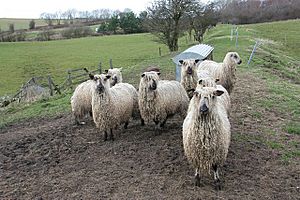Teeswater sheep facts for kids

A small flock of Teeswater sheep, Ingleby Greenhow
|
|
| Conservation status | ‘Vulnerable’ |
|---|---|
|
|
The Teeswater is a special kind of sheep that comes from Teesdale, England. These sheep are known for their long, shiny wool. Farmers mostly raise Teeswater sheep for their meat.
Teeswater sheep have lived in northern England, Great Britain for about 200 years. By the 1920s, there were very few of them left. Luckily, after World War II, more people started raising them again. Today, the Rare Breeds Survival Trust lists them as ‘vulnerable’. This means their numbers are still quite low, and they need protection.
The Teeswater Sheep Breeders' Association started in 1949. Their main goal is to help more Teeswater sheep be born and to keep the breed pure. They also want to show how good Teeswater rams are for breeding with other hill sheep. This creates strong "half-bred" lambs.
What Makes Teeswater Sheep Special?
The wool from a Teeswater sheep is very unique. It should be fine and long, with a beautiful shine. Each strand of wool hangs freely and does not get tangled easily. The fleece should not have any dark fibers. It should also feel the same all over the sheep's body.
Teeswater sheep produce wool without "kemp." Kemp is a coarse, chalky fiber that can make wool less valuable. This is a great quality that Teeswater sheep pass on to their lambs.
How Old Descriptions Help Us
In 1825, a writer named John Claudius Loudon described the Teeswater sheep. He wrote that they were different from another breed called the Lincolnshire sheep. Teeswater wool was not as long or heavy.
He also noted that Teeswater sheep had taller, thinner legs. Their bodies were thicker, firmer, and heavier. They were wider across their backs and sides. This meant they produced fatter and finer-grained meat.

